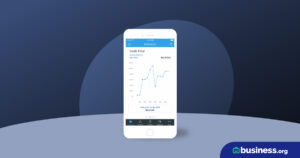💸 See if your business qualifies for a tax credit worth up to $26k per employee. 📞 Call Now: 855-979-9597
What Is a Balance Sheet?
We are committed to sharing unbiased reviews. Some of the links on our site are from our partners who compensate us. Read our editorial guidelines and advertising disclosure.
What is a balance sheet?
Need to quickly figure out if you’re making money or losing it? Then you need a balance sheet.
A balance sheet is a straightforward (but crucial!) financial document that balances your assets against your liabilities and equity. Luckily for the busy business owner, they’re pretty easy to create and read: one half of the sheet lists what your business owns while the other half lists how much you owe, along with how much of the company you or your shareholders own.
The information on a balance sheet gives you, your lenders, and your investors a quick overview of your business’s current financial health. In other words, when you need to take your business’s temperature, a balance sheet is your thermometer.
And along with a profit and loss statement (also called an income statement) and a cash flow statement, a balance sheet is one of your business’s most essential financial documents. You’ll be drawing up a lot of balance sheets, and if you want your business to stay in the black, you need to know how balance sheets work, how you read them, and how you can create your own.
What information is on a balance sheet?
Balance sheets draw on a simple equation, which is also one of the most basic accounting principles: assets = liabilities + equity. Of course, when we say “simple,” what we really mean is “less complicated than taxes,” but then again, what isn’t? So let’s look closer at what each term means:
- Assets refer to your current cash balance plus the dollar amount of anything your company owns, which includes property, equipment, inventory, accounts receivable, and anything else you could liquidate for cash.
- Liabilities refer to any money owed by your company. Typically, this category includes income tax, rent on office buildings, utility payments, wages paid to employees, and loans from banks and investors.
- Equity is also called “net worth” or “net assets,” and it’s the amount you or other shareholders would walk away with after debts to non-shareholders get paid off. If you’re the sole owner of your business, you call this owner’s equity. If external stakeholders own parts of your business, you call this shareholders’ equity.
Wondering why your assets need to equal both your liabilities and your equity, especially since “net assets” is another term for equity? Honestly, it’s kind of confusing, but try thinking of it like this: the only reason you have assets is because you took out a loan from a bank, accepted money from shareholders, or invested your own money in your business. Since your assets stem from a combination of liabilities and equity, the two halves of the equation need to balance.
So once you have all this information, it’s time to make sure the numbers all balance—or rather, the balance sheet makes sure they balance. Basically, the assets on one half of the sheet should equal the liabilities and equity on the other side of the sheet.
Say you take out a $10,000 loan. That means you have a $10,000 liability—but it also means you have $10,000 in assets. See? Balanced.
That’s obviously the easiest, most simplistic example; alas, creating your first balance sheet won’t be that easy. But that example gets at the basic principle of the thing, which is to make sure your assets, liabilities, and equity are all balanced.
By signing up I agree to the Terms of Use and Privacy Policy.
How can you prepare a balance sheet?
Most business owners choose one of three options to create balance sheets:
- Hiring an accountant or CPA
- Drawing up a balance sheet by hand
- Using accounting software
Using an accountant costs the most but comes with the least amount of risk—after all, an accountant is much less likely to make a balance sheet mistake than the rest of us are. (At least, they’d better be; that’s what we pay them for, right?) Plus, if a calculation is off, the liability lies with your accountant, not with you.
On the other hand, drawing up your own balance sheet is free . . . unless you make a costly mistake. But balance sheets are simple enough that you can catch errors quickly, if not on the current sheet then on the next one you draw up. You can create your own two-column balance sheet using spreadsheet software or even download an easy Excel balance sheet template that helps you put one together.
Accounting software strikes a happy medium between cost and ease. Though you can find good free accounting software, most software brands cost a monthly fee, which can range from under $10 to over $100.
The tradeoff for the cost? As long as you’ve entered your numbers correctly (which sometimes feels like a gamble if your software’s learning curve is sky high), you can generate balance sheets day in and day out without lifting more than a finger.
How can you draw up a balance sheet by hand?
If you’re set on doing your first balance sheet with pen and paper, open up your spreadsheet program or pick up your graphing paper and calculator and let’s get started.
1. List your assets
On the left half of your sheet, list your assets, starting with the most liquid assets and moving to least. Liquid assets are assets you can easily convert to cash, so you’ll want to start with your cash balance, then list the easiest items to cash out on, then the hardest items to cash out.
Another way to think about liquidity is in terms of time. Current assets include everything you can turn into cash within a year or less—such as inventory, like unsold bags from your boutique, or equipment, like your industrial bread maker. Long-term assets are things you couldn’t easily liquidate within a year, including long-term investments and intangible assets like copyrighted logos.
To keep things organized, you’ll want to split up your list of assets by category, or current vs. long term. At the end of each category, list the total; then at the very bottom of the assets column, list the sum total of all the assets.
2. List your liabilities
On the right half of your sheet, list your liabilities, starting with the most current debt owed (i.e., accounts payable, biweekly wages, or utility payments) to the longest-term debt (i.e., a five-year bank loan). Follow the same organization as the assets column, totaling each type of liability and then the sum total liability.
3. List your owner’s equity or shareholders’ equity
On the right half of your sheet—beneath the liabilities section and with its own heading—list your equity. Depending on your small business’s ownership structure, equity could include:
- Stock options, including common stock, treasury stock, and preferred stock
- Retained earnings, or money earned by the owners that they then reinvest in the business
- Paid-in capital, or additional money invested in the company that is not common stock
As with the other categories, total each type of equity, then list the sum total equity.
4. Check the balance
Does your assets section equal your liabilities and equity section? If so, great news: you’re in the clear! But if your liability and equity outweigh your assets, you’ll need to put in a few extra hours as you figure out how to restore the balance.
Compare top picks for business accounting software
Data as of 7/5/23. Offers and availability may vary by location and are subject to change.
*Only available for businesses with an annual revenue beneath $50K USD
**Current offer: 50% off for 6 mos. or 30-day free trial
‡Current offer: 70% off for 3 mos. Available for new customers only
The takeaway
Balance sheets offer just one perspective on your business’s financial health—but it’s a crucial one. Alongside profit and loss statements and cash flow statements, balance sheets can help your business grow, grow, and grow some more.
Want to draw up balance sheets on the go? Check out our piece on the best accounting apps for small businesses so you can get a quick look at your business’s health anywhere, anytime.
Related reading
FAQ
Assets, liabilities, and equity. See more about what these mean above.
The balance sheet is a financial statement that presents details about a company's assets, equity, and liabilities/debt. It offers valuable insights to analysts, enabling them to evaluate the company's capacity to cover immediate operational requirements, fulfill future debt responsibilities, and distribute profits to stakeholders.
Disclaimer
At Business.org, our research is meant to offer general product and service recommendations. We don't guarantee that our suggestions will work best for each individual or business, so consider your unique needs when choosing products and services.






